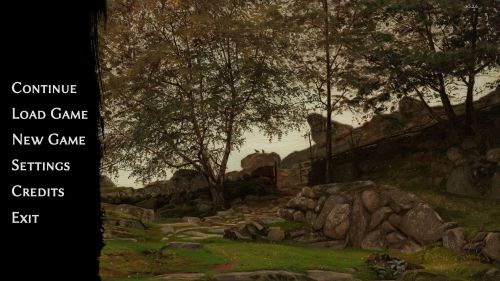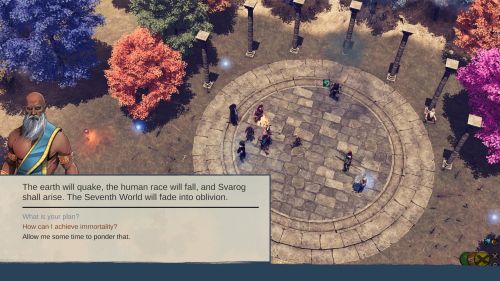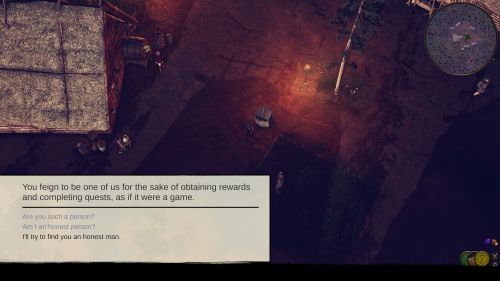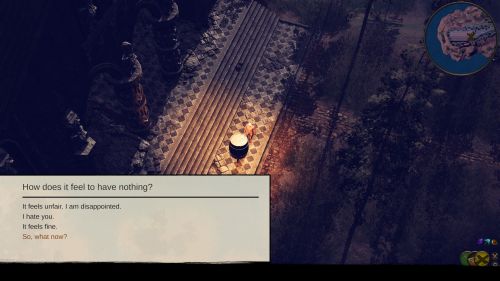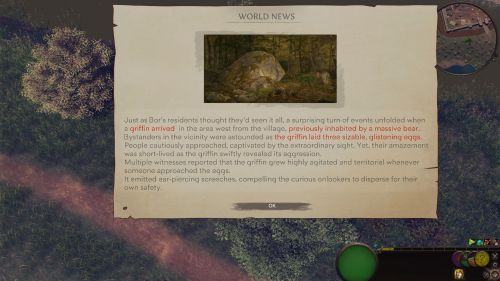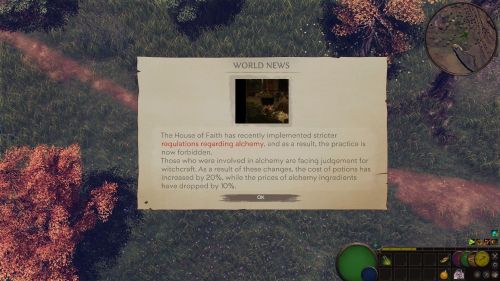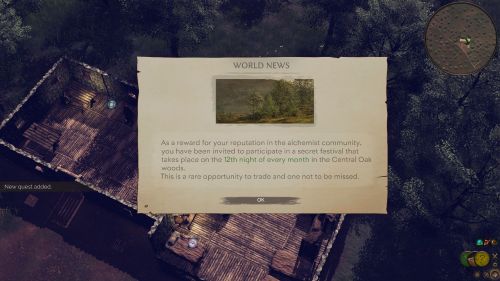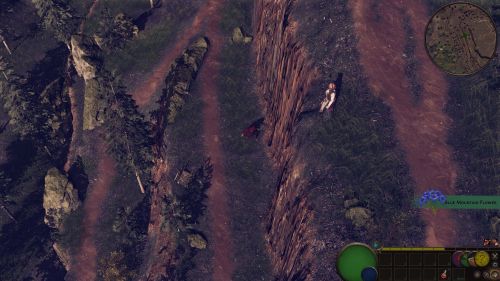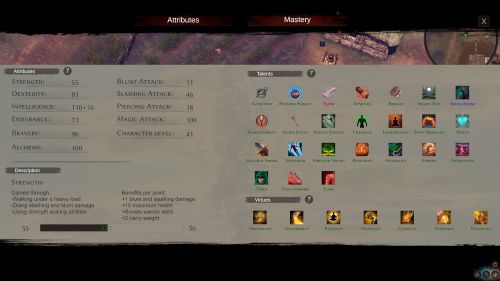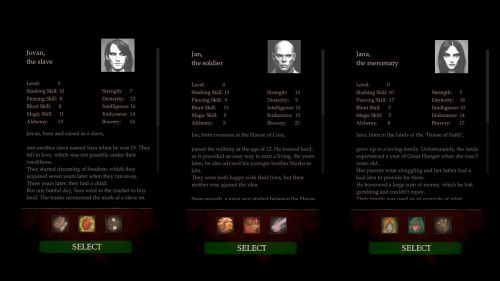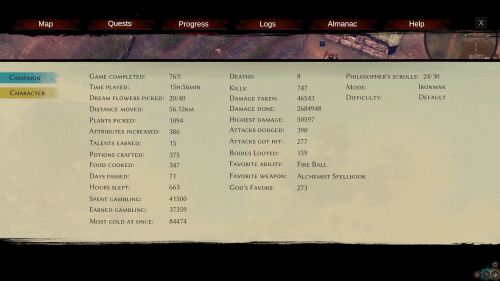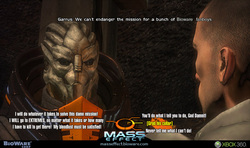RPG Codex Review: Svarog's Dream
RPG Codex Review: Svarog's Dream
Codex Review - posted by Darth Roxor on Wed 25 September 2024, 20:52:14
Tags: Svarog's Dream; VI Game Forge[Review by BosanskiSeljak]
Just before completing Svarog's Dream, I finished another recently released low budget open world ARPG made by 2 Eastern Europeans. It was mediocrity realized, hence this review isn't about Wigmund. So, why bring up this forgettable game in the first place? Whereas Wigmund failed to deliver anything of value, Svarog's Dream is a lesson on how a vision, focused design and a few bold decisions propels a game above its counterparts.
At first glance, Svarog’s Dream appears to be just another bland Diablo clone. I even judged it as such. Fortunately, this can’t be farther from the truth. Developed by a single dev from Serbia and his wife, Svarog’s Dream is a solid cRPG which manages to introduce some innovative mechanics in a rarely explored setting coupled with a very reactive world. This is a labour of love which deserves more attention, lost in a sea of average and derivative works.
Now, let's take a deep dive and see what makes Svarog’s Dream more than a run-of-the-mill RPG…
Set in the 8th century, Svarog’s Dream explores the Christianization of the Slavs, with a strong emphasis on Old Faith mythology. You play as a spirit, dispatched into the world by the God of the Underworld, Veles, quickly finding yourself entangled in a series of conflicts. The main conflict arises from the Old Gods engaged in a power struggle with the “One God”. Wrapped in this are the rising tensions on Earth between the House of Faith (Christianized, not-so-subtle representation of a Serbian “Kingdom” with a King Lazar) and the House of Coin (not-so-subtle representation of the Ottomans), while the Free People desperately cling to the last vestiges of their old faith. The depiction of Slavic mythology remains mostly faithful, all the while weaving historical references into the narrative.
The plot is on rails for the first half, acquainting the player with the setting. Gradually, the main quest unravels into branching storylines that allow you to experience the various conflicts from the ground up, culminating in 4 distinct endings. Surprisingly, Svarog’s Dream embraces philosophical discussions more than one might expect. A recipe for disaster, but the writer successfully tows the line without crossing into preaching or cliché. With this lean into philosophy, you’re challenged to truly embody that which you preach. For instance, being a virtuous character isn’t about selecting the “good” dialogue options or simply completing tasks for the side you support. You must prove your commitment through actions, such as sacrificing your possessions for a meager loaf of bread, leaving you naked in the street (and warned by guards to stop being a degenerate if they see you). Even then, you’ll be judged in story and gameplay choices whether your actions go along with your words or are merely pretending. It’s a game that makes you question your own morals. “Why is charity so difficult, even when it’s just pixels on a screen?”.
Despite the depth of the narrative, the writing suffers from awkward syntax and grammatical errors, a symptom of being written by a small ESL team. It's also sorely lacking dialogue which flows smoothly. However, the story remains compelling, enhanced by bold decisions, branching events and the exploration of philosophical ideas & religion. All of this is wrapped in a setting that is underutilized in RPGs.
The true highlight of the game, however, comes in the form of…
The standout feature of Svarog’s Dream is its ever-changing world, which reacts to random events and player choices, extending beyond the main narrative. Each playthrough will have unique scenarios, and I could easily provide multiple examples for every small action that causes a reaction just from a single (experimental) playthrough. There are several systems incorporated into the game to achieve this:
Day/Night and Seasons Cycle: These cycles influence quests, gameplay mechanics/character attributes and the behaviour of creatures, determining which mobs are active or hostile at a given time.
Random World Events: These appear spontaneously, providing the player with optional activities. For example, Mokosh may bless the fields with bountiful crops at the beginning of summer, an underworld trader arrives in a town but locals are weary and may drive him out, a certain creature has invaded an area, etc. The abundance of these events, and whether they're good or bad, are influenced by the amount of chaos you've let into the world through choices.
World Events Resulting from You: Arguably the game’s strongest feature, these events are direct outcomes of your character’s actions. Successfully dispatching a threat might lead to the opening of an inn a few days later, proving yourself a top alchemist gets you invited to a secret society, etc. Conversely, not completing/refusing a quest to eliminate a creature terrorizing the village might result in a useful NPC getting mauled. If you kill it, a far more deadly creature might call the den its home. There are countless examples, so many that I cannot do the game justice by listing a couple.
Obviously, main quest choices also add to these changes in a drastic way. Entire cities can be taken over and replaced with factions you support.
The combination of these elements is already an impressive feat, but all of that would go to waste without proper world design. After all, it is a fully open world which comes with a whole lot of problems if no thought is put into it. I’ve seen the world likened to Skyrim solely for its openness. In reality, Svarog’s Dream is more akin to properly designed open worlds like in Gothic. Items are hand placed instead of relying on mob drops, dangerous & safe areas are logical, there is a clear hierarchy in mobs and most importantly, enemies do not scale to your level. NPCs work on a schedule further amplifying the feeling of a lived in world. While the map is available to you from the start, fog of war restricts vision on a large portion of the map until certain events in the main quest. As with Gothic, this encourages thought when exploring, especially in unknown locations. Additionally, the sound design complements the world. While there are mediocre elements, the ambience in forests and uninhabited areas improves exploration, highlighting the difference between biomes, sunny days and dangerous nights.
The design of this world provides a strong foundation to boost other elements, even if they do not live up to the same standards, which naturally leads us to…
While the actual mechanics of combat in Svarog’s Dream are average, the system benefits greatly from the well crafted world and character building. Isometric action combat with auto-attacks, occasional kiting and active abilities running on cooldowns is the quick synopsis on what to expect. An additional mechanic is the spirit form, which allows you to leave your body and scout out an area (while you remain vulnerable). Death is a massive penalty in this game so the use of the spirit form is essential to many builds for a reason that will soon come apparent. This provides a small boost to somewhat lacking combat and lets you prepare and position yourself for fights. In other words, there is an added layer of thought that goes into it, rather than mindlessly running through the world.
Difficulty varies depending on how you play. The main questline is easy to the point you’re rushing through fights and mowing down everything in your way on the base difficulty. Hard difficulty somewhat counteracts this but utilizes what I refer to as "lazy difficulty", i.e. simply cranking up enemy HP, damage taken and the amount of mobs. On the other hand, the open world lets you create your own difficulty, going as far as letting you search for late game fights from the start. Finally, while combat is single character, you can hire AI controlled mercenaries to follow and fight with you. As mentioned in the intro, looks can be deceiving because Svarog's Dream can easily be dismissed as yet another Diablo-clone at first glance. Combat mechanics can be compared to Diablo, but that is where the similarities end. Enemies roam in small packs or solo depending on what they are and usually stick to their natural habitat. There is only one instance in the entire game where droves of mobs are thrown at you, otherwise the game sticks to its more grounded encounter design.
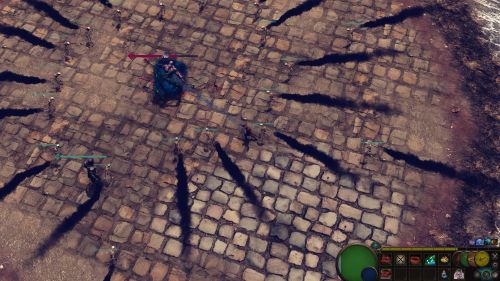
Blasting away with my Alchemist's Spellbook, invincible to all magic attacks by abusing potions, supported by an army of undead (A Necromancer ability)
In contrast, character building offers depth and flexibility, creating many possibilities for unique builds. Rather than create a character from scratch, you select from three distinct people with their own attributes, talents and personal quests. The following characteristics make up your PC:
Main Attributes: Strength, Dexterity, Intelligence, Endurance, Bravery, Alchemy. Increase through learn-by-doing.
Secondary Attributes: Blunt, Slashing, Piercing, Magic Proficiency. Increase through learn-by-doing.
Talents: Each character starts with 2 positive talents and additional ones are unlocked through various ways in gameplay. For example, excessive potion use results in addiction, diminishing potion effects but lowering cooldowns significantly. Be careful, because "talents" can be negative as well. Each new character starts with a unique negative talent and more can be tacked on. A broken arm crippled my Hunter, penalizing Dexterity & slowed learning. These negative talents can be removed by a healer if they are physical, or through spending "God's Favours" (See Additional Mechanics).
Virtues: Seven in total, unlocked based on decisions made during key story beats.
The high level cap and learn-by-doing system in Attributes lends itself to a slow feeling of growth that doesn't give a satisfying feeling of progression. Attributes matter on the macro scale but fail to feel impactful until a few hours of playing. An increase of 1 will make virtually no difference to your character meaning you'll only start feeling stronger in increments of 5-10 points. Thus, while stats do matter, the feeling of growth is hampered by half-assed execution. Fortunately, the class-based system pack a punch.
In conjunction with attributes is the varied class system. There are a total of 12 classes (see below) and you are able to dual class from the start.
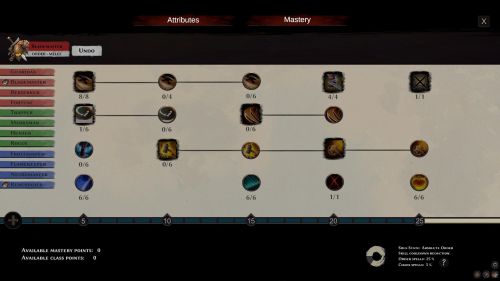
Classes and their respective skills - circles represent passive abilities and squares represent active abilities
Class points (gained through leveling) are used to unlock branches of the tree so you can then use the same points to unlock passive & active abilities. To cap it all off, each ability is upgradeable several times. As a result, even a late game character cannot obtain mastery in a single class if they choose to dual class. Consequently, the system encourages strategic character building, choosing between a specialized master or a jack-of-all-trades. All of these systems combine to give many customization options. The lack of impact in combat mechanics and attributes is remedied by the vastly different feelings between classes. Most classes and their respective abilities change gameplay, in terms of how you approach fights, exploration, positioning and overall tactics for getting through tough encounters. A hunter can tame wild animals and personally control them, a necromancer summons their own personal army and sacrifices them for mana, melee classes range from tanks, berserkers and swordsman who get in and out quickly, just to name a few. Each group (Melee, Rogue & Magic) work in this way, but the game allows for deviations from the formula. For example, my favourite build was an alchemist relying on passive damage abilities tied to the alchemy skill and heavily utilizing potions (to the point where I could keep myself virtually invincible against everything but melee attacks), completely foregoing active abilities.
Gear & equipping your character hovers around average, showcasing nothing you haven't seen before. There is an extra layer added with camouflage, useless for a fighter, but perfect for hunters & rogues walking around in the shadows, making the most out of positioning and stealing.
Thus far, we have a strong story & setting, very reactive world and a highly customizable character system. Is there anything that can bring it down? Well, sort of…
Intricately woven into both story and gameplay, permadeath is the most distinct feature and bold design decision in Svarog’s Dream. From the moment you start, the game makes it clear there is no save scumming. You only have one save file which overwrites itself, you cannot load any previous saves, the game does not pause during dialogue and merely slows down when you open the menu. This creates a heightened sense of tension, making you think twice before rushing into unknown territory or taking a break without making sure your surroundings are safe. In this way, permadeath ties together mechanics such as the spirit form and the world design. You only have one chance for every battle you engage in so use everything at your disposal. Use the spirit soul to scout out your surroundings to know what to expect, buff yourself when you see an unrecognizable enemy who is obviously stronger than you, be alert at night and heed the warnings of locals when they reference certain areas of the map.
If your character dies, you’re returned to Veles who sends you out to inhabit a new body, giving you three new choices. Virtues and character level remain intact, while Attributes & Talents are replaced by the next character you choose. Your previous character's corpse remains on the map permanently with your old inventory, and looting it will leave the nude corpse behind as you carry on with your mission. There is no way to game the system as death-scumming is discouraged by design. Consistently dying does buff the attributes of your next character choices, but has unforeseen consequences on the world, raising the difficulty as a result. Talents are reset to the default 2 positive, 1 negative for every new character, whereas anyone playing for more than an hour would have accumulated more. Due to your level remaining static, purposefully dying to roll an overpowered character is off the table and only a reasonable option if you'd like to change classes and have a better foundation to work off of. However, the ample opportunities to reclass makes this a moot point. The first death also locks you out of content, as the starting 3 choices are the only ones with a personal quest attached to them.
The developers have thought out many scenarios in this regard, even adding in some humour if you constantly find yourself back in the underworld. Do not be surprised if Veles teaches you a lesson and sends you back as a Wolf or several other non-human entities without your consent.
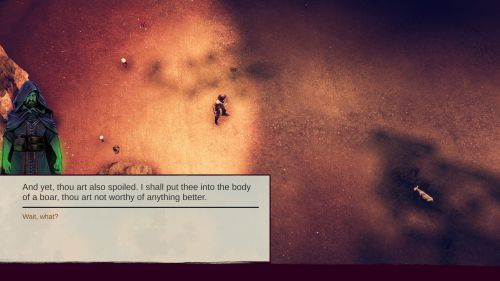
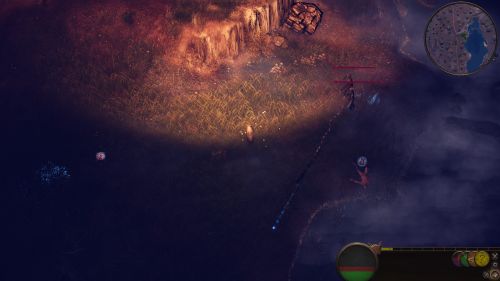
Punished by Veles for repeatedly dying and learning my lesson in the form of a Boar (unlocking the ability to become one after looting the corpse with the next character)
If this mechanic is brilliantly implemented, why did I hesitate when introducing it? For the simple reason that the robust character building loses some of its strength because you cannot fully customize. The predefined choices provide a solid foundation, but the interaction between attributes, talents and class abilities is objectively limited by the constraints of permadeath. There are many ways you can reclass, and the permadeath mechanic is done competently, but I cannot shake the feeling of wanting to create something from scratch. Letting you adjust points and add talents to your first character who have their own personal quest, then leaving you as a wandering soul would be the perfect middle ground without changing the tone of the game.
Everything talked about so far is the core of the game, but I will be remiss if I did not mention some other aspects. Unfortunately, Svarog's Dream employs mechanics seen in many (usually mediocre) games:
Crafting/Smelting: Used to upgrade gear. Unless you figure out where to farm materials, they are scarce so you avoid crafting hell found in many other games.
Cooking: Managing hunger boosts health regeneration and limits your options in fast travel if you do not keep up. Find recipes or experiment with the ingredients at your disposal.
Alchemy: The most robust system and tied to a main attribute. Find recipes or experiment. Your alchemy stat determines how many potions or food items you can make with 1 ingredient and your success rate when mixing.
On top of the usual are some more unique mechanics:
God’s Favours: Earn the favour of certain Gods by performing tasks they like (in gameplay - not a quest), and you can redeem these for rewards. Certain alignments in story grant you many favours and let you build your character in a unique way. Redeemable options range from simple XP boosts, additional talents and/or legendary gear.
Animal Transformation: There are magical necklaces available for purchase from a specific vendor that allow you to transform into the various animals found in the game. Used to hide in the shadows, sneak into places and faster traversal across the map. They can also be unlocked through gameplay, such as looting the corpse of an animal you were turned into by Veles.
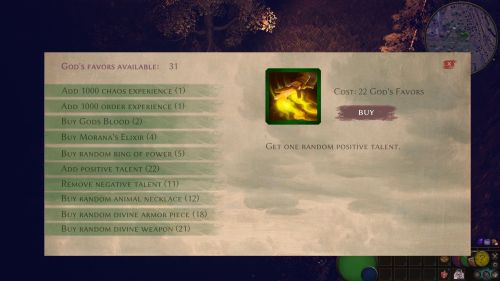
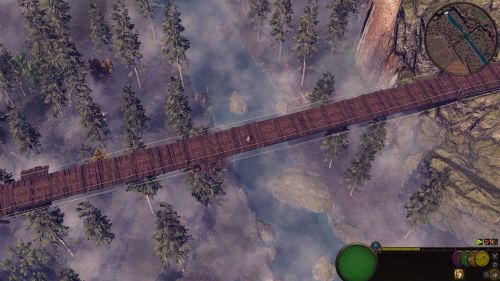
God's Favours used to give my unlock over 15 talents for my character Transformed into a bunny to avoid paying a toll to a dangerous troll guarding the bridge
There is nothing groundbreaking here, and these systems are typically implemented to pad playtime and provide mindless busy work. However, they are straightforward enough to give yourself an advantage if used correctly, without being unnecessarily obtuse. I love it when games introduce mechanics which I don't have to interact with if I don't want to, and Svarog's Dream does exactly that. Despite not being the most comprehensive, there are still unique uses in gameplay which means Svarog's Dream meets bare minimum expectations as to not detract from the game as a whole.
I've already given a lot of praise and emphasized all of the high points, so what is objectively bad?
This is a very consistent game across the board, but as with any ambitious project by a small team with a lack of budget, there will be some misses. Visually, Svarog’s Dream is lacking, and while the sound design alleviates that to some extent, there are lackluster moments with combat being the main culprit. I do not get close to the same feeling walking through villages here as I did with The Witcher, the most atmospheric non-Western fantasy game I've played to date. Additionally as previously stated in the story section, there are mistakes and it's written by a non-native speaker so you won’t find a classical literary work here, which hampers the flow of dialogue.
Nonetheless, the biggest detractor to overall gameplay is the jank, particularly in movement. The game lacks visual distinction with no indicators of what you can and cannot move through. Therefore, WASD is out of the question in combat and without a pause feature, you’re rolling the dice with pathfinding when in a heated battle. There are also occasional scripting issues that can disrupt the experience. Finally, while the mechanics mentioned previously are mostly out of the way, there are a couple of builds which make the sin of making you grind. The same alchemist build I praised earlier relies on the alchemy skill which increases by picking plants, cooking and mixing potions so getting to the higher levels leads to more plants picked than total enemies killed. Grinding is not compulsory, but needed to complete extra challenges sprinkled around the map. Still, better design would allow you to complete what you want with skill and planning instead of grinding.
Hopefully some of these issues are fixed in the upcoming expansion.
As a whole, Svarog’s Dream is a remarkable achievement for a two-person team and is a testament to what bold decisions and a vision can achieve with a low budget. Its setting, world design, reactivity and character building coupled with a unique and well-implemented permadeath mechanic elevates the game above what's to be expected in today's RPGs. Taking combat, sound design and art direction to a higher level would cement Svarog's Dream as a truly great game. As of now, it remains a little gem that's flown under the radar and would be an enjoyable experience for many who are intrigued by the mechanics at display.
Just before completing Svarog's Dream, I finished another recently released low budget open world ARPG made by 2 Eastern Europeans. It was mediocrity realized, hence this review isn't about Wigmund. So, why bring up this forgettable game in the first place? Whereas Wigmund failed to deliver anything of value, Svarog's Dream is a lesson on how a vision, focused design and a few bold decisions propels a game above its counterparts.
At first glance, Svarog’s Dream appears to be just another bland Diablo clone. I even judged it as such. Fortunately, this can’t be farther from the truth. Developed by a single dev from Serbia and his wife, Svarog’s Dream is a solid cRPG which manages to introduce some innovative mechanics in a rarely explored setting coupled with a very reactive world. This is a labour of love which deserves more attention, lost in a sea of average and derivative works.
Now, let's take a deep dive and see what makes Svarog’s Dream more than a run-of-the-mill RPG…
Set in the 8th century, Svarog’s Dream explores the Christianization of the Slavs, with a strong emphasis on Old Faith mythology. You play as a spirit, dispatched into the world by the God of the Underworld, Veles, quickly finding yourself entangled in a series of conflicts. The main conflict arises from the Old Gods engaged in a power struggle with the “One God”. Wrapped in this are the rising tensions on Earth between the House of Faith (Christianized, not-so-subtle representation of a Serbian “Kingdom” with a King Lazar) and the House of Coin (not-so-subtle representation of the Ottomans), while the Free People desperately cling to the last vestiges of their old faith. The depiction of Slavic mythology remains mostly faithful, all the while weaving historical references into the narrative.
The plot is on rails for the first half, acquainting the player with the setting. Gradually, the main quest unravels into branching storylines that allow you to experience the various conflicts from the ground up, culminating in 4 distinct endings. Surprisingly, Svarog’s Dream embraces philosophical discussions more than one might expect. A recipe for disaster, but the writer successfully tows the line without crossing into preaching or cliché. With this lean into philosophy, you’re challenged to truly embody that which you preach. For instance, being a virtuous character isn’t about selecting the “good” dialogue options or simply completing tasks for the side you support. You must prove your commitment through actions, such as sacrificing your possessions for a meager loaf of bread, leaving you naked in the street (and warned by guards to stop being a degenerate if they see you). Even then, you’ll be judged in story and gameplay choices whether your actions go along with your words or are merely pretending. It’s a game that makes you question your own morals. “Why is charity so difficult, even when it’s just pixels on a screen?”.
Despite the depth of the narrative, the writing suffers from awkward syntax and grammatical errors, a symptom of being written by a small ESL team. It's also sorely lacking dialogue which flows smoothly. However, the story remains compelling, enhanced by bold decisions, branching events and the exploration of philosophical ideas & religion. All of this is wrapped in a setting that is underutilized in RPGs.
The true highlight of the game, however, comes in the form of…
World Design & Reactivity
The standout feature of Svarog’s Dream is its ever-changing world, which reacts to random events and player choices, extending beyond the main narrative. Each playthrough will have unique scenarios, and I could easily provide multiple examples for every small action that causes a reaction just from a single (experimental) playthrough. There are several systems incorporated into the game to achieve this:
Day/Night and Seasons Cycle: These cycles influence quests, gameplay mechanics/character attributes and the behaviour of creatures, determining which mobs are active or hostile at a given time.
Random World Events: These appear spontaneously, providing the player with optional activities. For example, Mokosh may bless the fields with bountiful crops at the beginning of summer, an underworld trader arrives in a town but locals are weary and may drive him out, a certain creature has invaded an area, etc. The abundance of these events, and whether they're good or bad, are influenced by the amount of chaos you've let into the world through choices.
World Events Resulting from You: Arguably the game’s strongest feature, these events are direct outcomes of your character’s actions. Successfully dispatching a threat might lead to the opening of an inn a few days later, proving yourself a top alchemist gets you invited to a secret society, etc. Conversely, not completing/refusing a quest to eliminate a creature terrorizing the village might result in a useful NPC getting mauled. If you kill it, a far more deadly creature might call the den its home. There are countless examples, so many that I cannot do the game justice by listing a couple.
Obviously, main quest choices also add to these changes in a drastic way. Entire cities can be taken over and replaced with factions you support.
The combination of these elements is already an impressive feat, but all of that would go to waste without proper world design. After all, it is a fully open world which comes with a whole lot of problems if no thought is put into it. I’ve seen the world likened to Skyrim solely for its openness. In reality, Svarog’s Dream is more akin to properly designed open worlds like in Gothic. Items are hand placed instead of relying on mob drops, dangerous & safe areas are logical, there is a clear hierarchy in mobs and most importantly, enemies do not scale to your level. NPCs work on a schedule further amplifying the feeling of a lived in world. While the map is available to you from the start, fog of war restricts vision on a large portion of the map until certain events in the main quest. As with Gothic, this encourages thought when exploring, especially in unknown locations. Additionally, the sound design complements the world. While there are mediocre elements, the ambience in forests and uninhabited areas improves exploration, highlighting the difference between biomes, sunny days and dangerous nights.
The design of this world provides a strong foundation to boost other elements, even if they do not live up to the same standards, which naturally leads us to…
Combat & Character Building
While the actual mechanics of combat in Svarog’s Dream are average, the system benefits greatly from the well crafted world and character building. Isometric action combat with auto-attacks, occasional kiting and active abilities running on cooldowns is the quick synopsis on what to expect. An additional mechanic is the spirit form, which allows you to leave your body and scout out an area (while you remain vulnerable). Death is a massive penalty in this game so the use of the spirit form is essential to many builds for a reason that will soon come apparent. This provides a small boost to somewhat lacking combat and lets you prepare and position yourself for fights. In other words, there is an added layer of thought that goes into it, rather than mindlessly running through the world.
Difficulty varies depending on how you play. The main questline is easy to the point you’re rushing through fights and mowing down everything in your way on the base difficulty. Hard difficulty somewhat counteracts this but utilizes what I refer to as "lazy difficulty", i.e. simply cranking up enemy HP, damage taken and the amount of mobs. On the other hand, the open world lets you create your own difficulty, going as far as letting you search for late game fights from the start. Finally, while combat is single character, you can hire AI controlled mercenaries to follow and fight with you. As mentioned in the intro, looks can be deceiving because Svarog's Dream can easily be dismissed as yet another Diablo-clone at first glance. Combat mechanics can be compared to Diablo, but that is where the similarities end. Enemies roam in small packs or solo depending on what they are and usually stick to their natural habitat. There is only one instance in the entire game where droves of mobs are thrown at you, otherwise the game sticks to its more grounded encounter design.

Blasting away with my Alchemist's Spellbook, invincible to all magic attacks by abusing potions, supported by an army of undead (A Necromancer ability)
In contrast, character building offers depth and flexibility, creating many possibilities for unique builds. Rather than create a character from scratch, you select from three distinct people with their own attributes, talents and personal quests. The following characteristics make up your PC:
Main Attributes: Strength, Dexterity, Intelligence, Endurance, Bravery, Alchemy. Increase through learn-by-doing.
Secondary Attributes: Blunt, Slashing, Piercing, Magic Proficiency. Increase through learn-by-doing.
Talents: Each character starts with 2 positive talents and additional ones are unlocked through various ways in gameplay. For example, excessive potion use results in addiction, diminishing potion effects but lowering cooldowns significantly. Be careful, because "talents" can be negative as well. Each new character starts with a unique negative talent and more can be tacked on. A broken arm crippled my Hunter, penalizing Dexterity & slowed learning. These negative talents can be removed by a healer if they are physical, or through spending "God's Favours" (See Additional Mechanics).
Virtues: Seven in total, unlocked based on decisions made during key story beats.
The high level cap and learn-by-doing system in Attributes lends itself to a slow feeling of growth that doesn't give a satisfying feeling of progression. Attributes matter on the macro scale but fail to feel impactful until a few hours of playing. An increase of 1 will make virtually no difference to your character meaning you'll only start feeling stronger in increments of 5-10 points. Thus, while stats do matter, the feeling of growth is hampered by half-assed execution. Fortunately, the class-based system pack a punch.
In conjunction with attributes is the varied class system. There are a total of 12 classes (see below) and you are able to dual class from the start.

Classes and their respective skills - circles represent passive abilities and squares represent active abilities
Class points (gained through leveling) are used to unlock branches of the tree so you can then use the same points to unlock passive & active abilities. To cap it all off, each ability is upgradeable several times. As a result, even a late game character cannot obtain mastery in a single class if they choose to dual class. Consequently, the system encourages strategic character building, choosing between a specialized master or a jack-of-all-trades. All of these systems combine to give many customization options. The lack of impact in combat mechanics and attributes is remedied by the vastly different feelings between classes. Most classes and their respective abilities change gameplay, in terms of how you approach fights, exploration, positioning and overall tactics for getting through tough encounters. A hunter can tame wild animals and personally control them, a necromancer summons their own personal army and sacrifices them for mana, melee classes range from tanks, berserkers and swordsman who get in and out quickly, just to name a few. Each group (Melee, Rogue & Magic) work in this way, but the game allows for deviations from the formula. For example, my favourite build was an alchemist relying on passive damage abilities tied to the alchemy skill and heavily utilizing potions (to the point where I could keep myself virtually invincible against everything but melee attacks), completely foregoing active abilities.
Gear & equipping your character hovers around average, showcasing nothing you haven't seen before. There is an extra layer added with camouflage, useless for a fighter, but perfect for hunters & rogues walking around in the shadows, making the most out of positioning and stealing.
Thus far, we have a strong story & setting, very reactive world and a highly customizable character system. Is there anything that can bring it down? Well, sort of…
PERMADEATH
Intricately woven into both story and gameplay, permadeath is the most distinct feature and bold design decision in Svarog’s Dream. From the moment you start, the game makes it clear there is no save scumming. You only have one save file which overwrites itself, you cannot load any previous saves, the game does not pause during dialogue and merely slows down when you open the menu. This creates a heightened sense of tension, making you think twice before rushing into unknown territory or taking a break without making sure your surroundings are safe. In this way, permadeath ties together mechanics such as the spirit form and the world design. You only have one chance for every battle you engage in so use everything at your disposal. Use the spirit soul to scout out your surroundings to know what to expect, buff yourself when you see an unrecognizable enemy who is obviously stronger than you, be alert at night and heed the warnings of locals when they reference certain areas of the map.
If your character dies, you’re returned to Veles who sends you out to inhabit a new body, giving you three new choices. Virtues and character level remain intact, while Attributes & Talents are replaced by the next character you choose. Your previous character's corpse remains on the map permanently with your old inventory, and looting it will leave the nude corpse behind as you carry on with your mission. There is no way to game the system as death-scumming is discouraged by design. Consistently dying does buff the attributes of your next character choices, but has unforeseen consequences on the world, raising the difficulty as a result. Talents are reset to the default 2 positive, 1 negative for every new character, whereas anyone playing for more than an hour would have accumulated more. Due to your level remaining static, purposefully dying to roll an overpowered character is off the table and only a reasonable option if you'd like to change classes and have a better foundation to work off of. However, the ample opportunities to reclass makes this a moot point. The first death also locks you out of content, as the starting 3 choices are the only ones with a personal quest attached to them.
The developers have thought out many scenarios in this regard, even adding in some humour if you constantly find yourself back in the underworld. Do not be surprised if Veles teaches you a lesson and sends you back as a Wolf or several other non-human entities without your consent.


Punished by Veles for repeatedly dying and learning my lesson in the form of a Boar (unlocking the ability to become one after looting the corpse with the next character)
If this mechanic is brilliantly implemented, why did I hesitate when introducing it? For the simple reason that the robust character building loses some of its strength because you cannot fully customize. The predefined choices provide a solid foundation, but the interaction between attributes, talents and class abilities is objectively limited by the constraints of permadeath. There are many ways you can reclass, and the permadeath mechanic is done competently, but I cannot shake the feeling of wanting to create something from scratch. Letting you adjust points and add talents to your first character who have their own personal quest, then leaving you as a wandering soul would be the perfect middle ground without changing the tone of the game.
Additional Mechanics
Everything talked about so far is the core of the game, but I will be remiss if I did not mention some other aspects. Unfortunately, Svarog's Dream employs mechanics seen in many (usually mediocre) games:
Crafting/Smelting: Used to upgrade gear. Unless you figure out where to farm materials, they are scarce so you avoid crafting hell found in many other games.
Cooking: Managing hunger boosts health regeneration and limits your options in fast travel if you do not keep up. Find recipes or experiment with the ingredients at your disposal.
Alchemy: The most robust system and tied to a main attribute. Find recipes or experiment. Your alchemy stat determines how many potions or food items you can make with 1 ingredient and your success rate when mixing.
On top of the usual are some more unique mechanics:
God’s Favours: Earn the favour of certain Gods by performing tasks they like (in gameplay - not a quest), and you can redeem these for rewards. Certain alignments in story grant you many favours and let you build your character in a unique way. Redeemable options range from simple XP boosts, additional talents and/or legendary gear.
Animal Transformation: There are magical necklaces available for purchase from a specific vendor that allow you to transform into the various animals found in the game. Used to hide in the shadows, sneak into places and faster traversal across the map. They can also be unlocked through gameplay, such as looting the corpse of an animal you were turned into by Veles.


God's Favours used to give my unlock over 15 talents for my character Transformed into a bunny to avoid paying a toll to a dangerous troll guarding the bridge
There is nothing groundbreaking here, and these systems are typically implemented to pad playtime and provide mindless busy work. However, they are straightforward enough to give yourself an advantage if used correctly, without being unnecessarily obtuse. I love it when games introduce mechanics which I don't have to interact with if I don't want to, and Svarog's Dream does exactly that. Despite not being the most comprehensive, there are still unique uses in gameplay which means Svarog's Dream meets bare minimum expectations as to not detract from the game as a whole.
I've already given a lot of praise and emphasized all of the high points, so what is objectively bad?
The Meh, the Bad, and the Ugly
This is a very consistent game across the board, but as with any ambitious project by a small team with a lack of budget, there will be some misses. Visually, Svarog’s Dream is lacking, and while the sound design alleviates that to some extent, there are lackluster moments with combat being the main culprit. I do not get close to the same feeling walking through villages here as I did with The Witcher, the most atmospheric non-Western fantasy game I've played to date. Additionally as previously stated in the story section, there are mistakes and it's written by a non-native speaker so you won’t find a classical literary work here, which hampers the flow of dialogue.
Nonetheless, the biggest detractor to overall gameplay is the jank, particularly in movement. The game lacks visual distinction with no indicators of what you can and cannot move through. Therefore, WASD is out of the question in combat and without a pause feature, you’re rolling the dice with pathfinding when in a heated battle. There are also occasional scripting issues that can disrupt the experience. Finally, while the mechanics mentioned previously are mostly out of the way, there are a couple of builds which make the sin of making you grind. The same alchemist build I praised earlier relies on the alchemy skill which increases by picking plants, cooking and mixing potions so getting to the higher levels leads to more plants picked than total enemies killed. Grinding is not compulsory, but needed to complete extra challenges sprinkled around the map. Still, better design would allow you to complete what you want with skill and planning instead of grinding.
Hopefully some of these issues are fixed in the upcoming expansion.
Should I Play This?
As a whole, Svarog’s Dream is a remarkable achievement for a two-person team and is a testament to what bold decisions and a vision can achieve with a low budget. Its setting, world design, reactivity and character building coupled with a unique and well-implemented permadeath mechanic elevates the game above what's to be expected in today's RPGs. Taking combat, sound design and art direction to a higher level would cement Svarog's Dream as a truly great game. As of now, it remains a little gem that's flown under the radar and would be an enjoyable experience for many who are intrigued by the mechanics at display.





